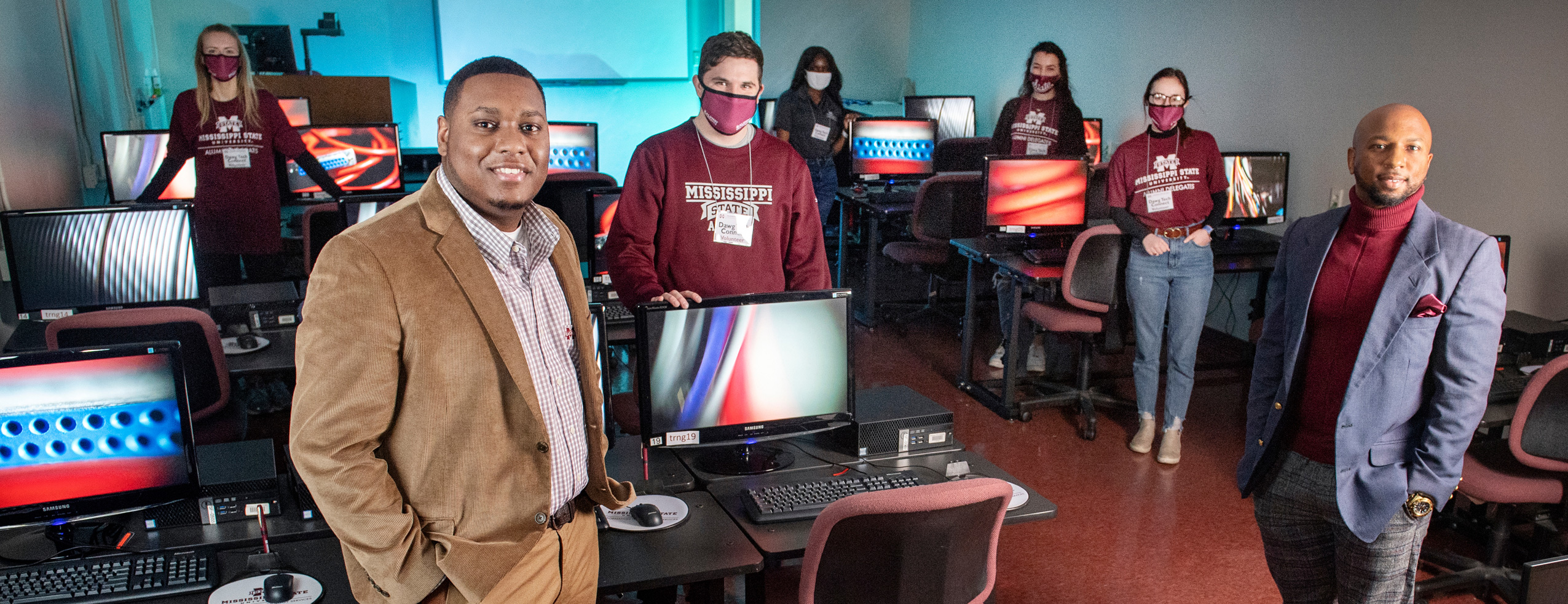

In the weeks leading up to the 2020 fall semester, Mississippi State University invested heavily in new classroom technology to bring safe, quality and familiar educational experiences to its nearly 23,000 students.
Ordering, installing and testing the new equipment in the midst of a global pandemic took a Herculean effort from the university’s Information Technology Services staff. For the task of supporting the university family as it learned to navigate that new technology, ITS called in reinforcements—student volunteers from across campus.
Desktop services manager Ronald Gatewood said faculty already had a lot to manage in making their classes accessible both for in-person and virtual students, so the goal of ITS was to make tech support the least of their worries.
“A lot of faculty had never used this technology, so we anticipated the need for additional support and brainstormed ways to supply it,” explained Gatewood, a three-time MSU alumnus with a doctorate in instructional systems and workforce development.
“We have full-time staff and a team of student workers, but that was not enough to cover all of the classrooms in those first few weeks when faculty were learning the equipment and we were working kinks out of the system,” he continued. “That’s when we turned to student volunteers.”
Called Dawg Tech Connect, the new volunteer program trained information technology services majors from the College of Education, as well as students from the College of Arts and Sciences and members of the Alumni Delegate, Foundation Ambassador and Orientation Leader student groups, in how to troubleshoot common problems that arise with classroom technology. They also were given an online forum and immediate access to ITS staff when more advanced support was needed.
During the first two weeks of the fall semester, the students were assigned specific classrooms or buildings, which they would monitor for any sign of technical difficulty. Gatewood called it a win-win situation for all involved.
“The student groups were in need of volunteer hours, since most of their opportunities had dried up due to COVID-19, and the ITS majors got great hands-on experience dealing one-on-one with clients,” Gatewood explained. “Having the students monitoring the classroom situations also freed up our staff to handle the more technical problems that came up with our new on-campus technology and increased demand for online education and remote working capabilities.”
“We have full-time staff and a team of student workers, but that was not enough to cover all of the classrooms in those first few weeks when faculty were learning the equipment and we were working kinks out of the system. That’s when we turned to student volunteers.” ~ Ronald Gatewood
The volunteers were especially helpful in the nontraditional classrooms that were established in campus performance spaces and athletic venues to accommodate physical distancing, according to Brian Rude, a professor in animal and dairy science who taught last fall in the Newell-Grissom Building, the home of MSU volleyball. He said the on-site support helped ease the “what if” worries that came from teaching in a sports arena using unfamiliar technology.
“It was a tremendously humbling experience for me,” Rude said. “Those students were ready to jump in the moment there seemed to be a problem, so the lecture wasn’t impacted at all. Between them and the cleaning crew that came in between classes, there were six to 10 people every day doing things just so I could teach face-to-face. It made me feel like I needed to do a great job so their efforts would not be in vain.”
Volunteer Taylor Ball, now a graduate student after earning a bachelor’s in information technology services in December, said he felt that Dawg Tech Connect was a great opportunity to serve the university and showcase his skills.
“I was happy to help and took it as an opportunity to learn new things and get more experience in the field,” the Louisville native said.
Though he was assigned to Allen Hall and Old Main Academic Center, Ball often took on extra shifts to help when he knew areas were shorthanded.
“If everything was fine in my assigned area and I saw an issue come across the message board, I’d excuse myself to go see if I could help,” Ball said. “Why not take the initiative and go that extra step if there’s a way to help others?”
Ball’s dedication did not go unnoticed by his supervisors. He was offered a paid ITS student worker position when the volunteer program wrapped for the semester. In addition to his classes, he already worked full time on second shift with nearby manufacturer PACCAR, but he said he felt lucky and grateful for the additional work within his field of study.
“I’ve been pretty busy, but I wouldn’t take anything away,” Ball said. “I’m always excited to learn about technology and that’s why I love it—it’s never stagnant. You’re learning something every day and I know in this field I will never get bored because there’s always something new.”
Top image: To help faculty adapt to new classroom technology, MSU’s Information Technology Services trained student volunteers from campus organizations to provide on-site support. ITS desktop services manager Ronald Gatewood (front right) said it was a win-win situation that kept classes on track and provided valuable customer-service experience to students like Taylor Ball (front left), an information technology services major whose success turned his volunteer position into a paid, part-time position.
By Susan Lassetter, Photos by Megan Bean
